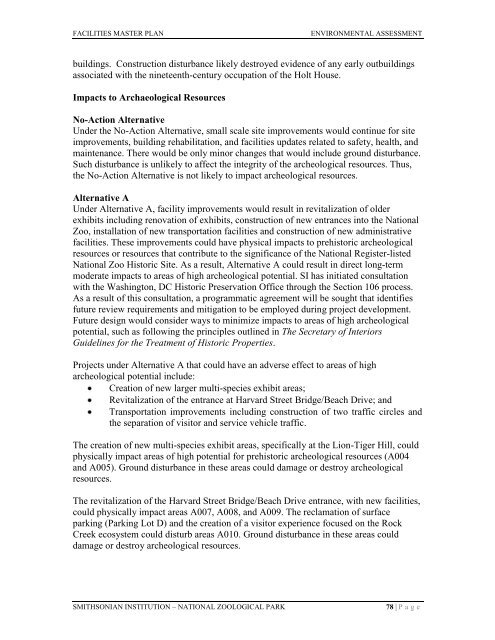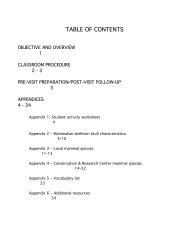facilities renewal master plan - National Zoo - Smithsonian Institution
facilities renewal master plan - National Zoo - Smithsonian Institution
facilities renewal master plan - National Zoo - Smithsonian Institution
You also want an ePaper? Increase the reach of your titles
YUMPU automatically turns print PDFs into web optimized ePapers that Google loves.
FACILITIES MASTER PLAN ENVIRONMENTAL ASSESSMENT<br />
buildings. Construction disturbance likely destroyed evidence of any early outbuildings<br />
associated with the nineteenth-century occupation of the Holt House.<br />
Impacts to Archaeological Resources<br />
No-Action Alternative<br />
Under the No-Action Alternative, small scale site improvements would continue for site<br />
improvements, building rehabilitation, and <strong>facilities</strong> updates related to safety, health, and<br />
maintenance. There would be only minor changes that would include ground disturbance.<br />
Such disturbance is unlikely to affect the integrity of the archeological resources. Thus,<br />
the No-Action Alternative is not likely to impact archeological resources.<br />
Alternative A<br />
Under Alternative A, facility improvements would result in revitalization of older<br />
exhibits including renovation of exhibits, construction of new entrances into the <strong>National</strong><br />
<strong>Zoo</strong>, installation of new transportation <strong>facilities</strong> and construction of new administrative<br />
<strong>facilities</strong>. These improvements could have physical impacts to prehistoric archeological<br />
resources or resources that contribute to the significance of the <strong>National</strong> Register-listed<br />
<strong>National</strong> <strong>Zoo</strong> Historic Site. As a result, Alternative A could result in direct long-term<br />
moderate impacts to areas of high archeological potential. SI has initiated consultation<br />
with the Washington, DC Historic Preservation Office through the Section 106 process.<br />
As a result of this consultation, a programmatic agreement will be sought that identifies<br />
future review requirements and mitigation to be employed during project development.<br />
Future design would consider ways to minimize impacts to areas of high archeological<br />
potential, such as following the principles outlined in The Secretary of Interiors<br />
Guidelines for the Treatment of Historic Properties.<br />
Projects under Alternative A that could have an adverse effect to areas of high<br />
archeological potential include:<br />
Creation of new larger multi-species exhibit areas;<br />
Revitalization of the entrance at Harvard Street Bridge/Beach Drive; and<br />
Transportation improvements including construction of two traffic circles and<br />
the separation of visitor and service vehicle traffic.<br />
The creation of new multi-species exhibit areas, specifically at the Lion-Tiger Hill, could<br />
physically impact areas of high potential for prehistoric archeological resources (A004<br />
and A005). Ground disturbance in these areas could damage or destroy archeological<br />
resources.<br />
The revitalization of the Harvard Street Bridge/Beach Drive entrance, with new <strong>facilities</strong>,<br />
could physically impact areas A007, A008, and A009. The reclamation of surface<br />
parking (Parking Lot D) and the creation of a visitor experience focused on the Rock<br />
Creek ecosystem could disturb areas A010. Ground disturbance in these areas could<br />
damage or destroy archeological resources.<br />
SMITHSONIAN INSTITUTION – NATIONAL ZOOLOGICAL PARK 78 | P a g e

















